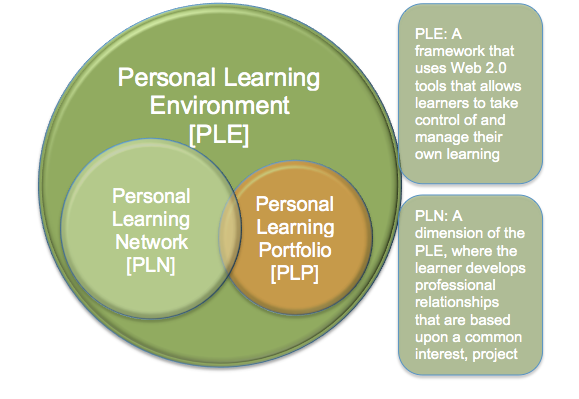e-Learning Ecologies MOOC’s Updates
Personalised e-Learning through intelligent Personal Learning Environments
Personal Learning Environments or PLEs have in some way attempted to address the needs and concerns of e-learnersby integrating two aspects within such environments, namely, a network and a portfolio ... both of which are personal. A Personal Learning Network or PLN brings together al the learner's contacts, sources, memberships, and any other medium which is employed for educational purposes. On the other hand a Personal Learning Portfolio represents the academic record of a learner by recording all the educational achievements and experiences of a specific student.
As shown in the image by Steve Wheeler both the PLN and PLP form part of the PLE thereby providing an integrated environment that takes into consideration both the student's previous academic history and the personal sources, media and providers that fuel the same student's academic needs and interests.
Over and above this how can such an environment be rendered intelligent? And why the need to be intelligent?
The fact that the learner's needs evolve over time is enough to ensure that an intelligent PLE accommodates the changing academic variables. The PLP is the most obvious of both components as a learning profile needs to evolve over time and thereby a up-to-date PLP needs to be generated. But even the PLN evolves over time and thereby an element of intelligence is required to ensure that the latest sources and information providers are guaranteed.



Thanks for all the examples. These examples give an idea how we can use this!
In an update, a short description is appreciated!
Some examples of PLEs include:
PLEX (Beauvoir, P. (2005). PLEX, Personal Learning Environment (PLE) theme. JISC-CETIS Conference. )
ELGG (www.elgg.org)
White, S., & Davis, H. (2011). Making it rich and personal: crafting an institutional personal learning environment. International Journal of Virtual and Personal Learning Environments , 2 (3), 1-18.
Pearson, E., Gkatzidou, V., & Green, S. (2009). A proposal for an adaptable personal learning environment to support learners needs and preferences. ascilite Auckland 2009, (pp. 749-757). Australia.
Casquero, O., Portillo, J., Ovelar, R., Benito, M., & Romo, J. (2010). iPLE network: An integrated elearning 2.0 architecture from a university’s perspective . Interactive Learning Environments , 18 (3), 293-308.
Cui, X., & Zhang, S. (2011). The Personalized E-Learning System Based on Portal Technology. In Z. e. al., CCIS (pp. 433-439). Heidelberg: Spirnger Verlag.
Morales, L., Garrido, A., & Serina, I. (2011). Planning and execution in a personalised e-learning setting. Lecture Notes in AI , 233-242.
Xu, D., Huang, W., Wang, H., & Heales, J. (2014). Enhancing e-learning effectiveness using an intelligent agent-supported personalised virtual learning environment: An empirical study. Information & Management , 430-440.
Aeiad, E., & Meziane, F. (2015). An adaptable and personalised e-learning system based on free web resources. In e. a. Biemann, NLDB 2015, LNCS 9103 (pp. 293-299). Switzerland: Springer International.
iClass 2016 (http://iclass.ined.uitm.edu.my/)
I think online portfolio's are a great way to present students work. During the year the portfolio can grow. You can even use it as an attachment by your curriculum vitae. One of the ways you can built a portfolio is uwing and website. A great way to use the students creativity, but also a good way to structure all the information. I'm curious about an example too!
Can you provide an example of where PLEs have been used for students?